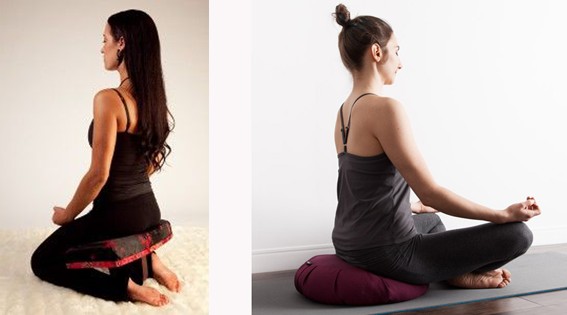In this video I present a powerful brain cross-training strategy, combining aerobic exercise with mental training – either working memory training (e.g. HighIQPro) or focused attention (FA) meditation to achieve long-term cognitive gains from the growth of new brain cells in the hippocampus.
.
.
In this blog article we’ll be looking more closely at focused attention meditation.
Focused Attention (FA) Meditation
This is a widespread style of Buddhist practice involves sustaining selective attention moment by moment on a chosen object, such the sensations of breathing or the sound of a metronome, or even the sensations of walking in a walking meditation.
This is a different type of meditation from open monitoring meditation in which attention shifts mindfully and non-reactively to anything that occurs in experience without focusing on without any explicit object.
The meditator constantly monitors the quality of their attention to sustain focus on the anchor. Let’s say that you are focusing on the sensation in the nostrils caused by breathing. You might notice that the focus has shifted to the pain in one’s knee, or to thoughts about what you have to do at work. The practice requires that you recognize that your attention has been distracted, and then ‘release’ the distraction, returning to the intended anchor such as the breath.
Attention Regulation Skills
FA Meditation develops three skills that regulate attention:
- A ‘meta’ monitoring awareness that allows you to quickly recognize distractions as they occur, without getting lost in them for prolonged periods.
- The ability to disengage from a distracting object without further involvement. The ability to let go of, or shift your attention away from, thoughts, emotions, sensations, that may be diverting your attention.
- The ability to re-focus on the chosen object of attention.
Progress can be measured by both the degree of effort required to sustain the intended focus and how cultivated the state of intense meditative absorption known as dhyana is.
.
As a beginner you are having to process more distractions and the three attention-regulation skills above are engaged more frequently. As you advance, attention rests more readily and stably on the chosen anchor. At the most advanced levels, the 3 regulative skills are invoked less and less frequently, and the ability to sustain focus thus becomes progressively effortless.
.
Mastery of this kind of meditation – over hundreds of hours of practice – comes with a sense of physical lightness and vigor, less emotional reactivity, and the need for sleep is said to be reduced.
The Concept of Relaxed, Non-Judgmental Concentration
Bringing attention to one thing or anchor can lead to a concentrated focus that naturally calms and collects the mind. This concentration can be deepened by intentionally aiming and sustaining a focused attention with your chosen anchor. When cultivating concentration, the anchor should be one that has a pleasant or at least neutral feeling tone.
Concentration requires a kind of relaxed attention – not one that is over-controlling. There is often a sense of making an effort to sustain concentration, of striving to control the mind and make something happen. It is important to not become caught in a striving effort. It is easy to be seduced into trying to achieve something, such as staying with the breath for much of the sitting, and then evaluating what is happening as a “good” or “not good” meditation. Ultimately what is wanted is a clear and relaxed attention without continual striving and evaluation..
How To Do Focused Attention Meditation
There are lots of web resources for how to do focused attention or breath focused meditation. Here I pick out some of the standard practices and points of advice.
Meditation Position
The position you meditate in is important. Sit in a comfortable position, where you feel upright, balanced and relaxed. Back straight, shoulders relaxed, head up. Close your eyes and relax the muscles around the eyes and face. You could choose to sit on a chair. Or you could use a meditation cushion (or any substitute) and sit cross-legged on a mat or carpet – like this:
.

Meditation Practice 1
Time required: 8 – 20 minutes
.
Duration for neuroplasticity effects: 60 minutes per week (e.g. 15 minute sessions 4 times a week), for 6-8 weeks.
The meditation has four progressive stages leading to a higher levels of meditative absorption or concentration. (I first practiced this in a jungle bungalow in Ao Nang, Thailand in 2013.) You could divide each session up equally, and use your phone’s timer to mark the transitions.
- STAGE 1. In the first stage you use counting to stay focused on the breath. Take a deep, breath, expanding your belly and keeping your shoulders relaxed. After the out-breath, just before your next in-breath, you count one. You then repeat the breath cycle and at the end of the second outbreath count two, and so on up to ten. And then you start again at one. If you lose track of your counting during this practice, simply start your counting again at one.
- STAGE 2. In the second stage you subtly shift where you attend to as you breathe, counting before the in-breath, anticipating the breath that is coming, but still counting from one to ten, and then starting again at one.
- STAGE 3. In the third stage you drop the counting and simply attend to the breath as it comes in and goes out, feeling the sensations of the chest and belly and nose as you breath in and out. If you get distracted by sensations in other parts of the body, or thoughts or images that take you out of the zone of your focus, gently turn your attention back to the breath and the sensation it provides.
- STAGE 4. In the final stage the focus of concentration narrows and sharpens, so you pay attention to the subtle sensation on the tip of the nose where the breath enters and leaves the body. Once again, you should be gaining useful practice in the three attention skills of monitoring, dis-engaging from distraction and re-focusing on the focal point.
Meditation Practice 2
Time required: 5 – 30 minutes
.
Duration for neuroplasticity effects: 60 minutes per week (e.g. 20 minute sessions 3 times a week), for 6-8 weeks.
.
This is essentially doing just Stage 3 in the 4 stage method above.
- Take a deep, cleansing breath, expanding your belly and keeping your shoulders relaxed, and hold it in for the count of six. Exhale, and repeat twice more.
- Breathe normally, and focus your attention on your breathing. As you breathe expand your belly rather than moving your shoulders up and down. This is called abdominal breathing. Don’t breathe too quickly or too slowly; just breathe at a natural rate, but more deeply. You could try to breathe out for a little longer than you breath in which has a relaxing effect. If your thoughts drift toward the stresses of the day ahead or of the day behind you, gently refocus on your breathing and remain in the present moment.
- Continue this for as little or as long as you like, and as you continue you should notice that your body is more relaxed and your mind is more centered.
Meditation Practice 3: Brain Cross Training Example
Used in a neurogenesis study by Shors and colleagues
.
Time required: x2 session a week, for 8 weeks
- 20 minutes of counting meditation (e.g. Stage 1 or Stage 2 of Meditation Practice 1 above).
- 10 minute of walking meditation with close attention to each footfall.
- Aerobic exercise: gym treadmills or stationary bicycles at a moderate pace for 30 minutes (with five minutes of warming up and five minutes of cooling down).
Common Issues for Meditators
Mind Wandering – Getting Lost In Thought
If you find your thoughts drifting a lot at first, don’t worry that you’re doing it ‘wrong’. Noticing that you’ve drifted and refocusing to your breathing is part of the practice. At first, you may be surprised at how active and uncontrolled your mind is. Don’t be concerned but accept and patiently “sit with” whatever comes up. As the meditation expert Tara Brach advises:
“There is no need to get rid of thoughts; this is not the purpose of meditation. Rather, we are learning to recognize when thinking is happening so we are not lost in a trance—believing thoughts to be reality, becoming identified with thoughts. Because we are so often in a thinking trance, it is helpful to quiet down some. Just like a body of water stirred up by the winds, after being physically still for a while, your mind will gradually calm down…It takes practice to distinguish the trance of thinking – fantasy, planning, commentary, dreamy states – from the presence that directly receives the changing experience of this moment.”
Physical Pain (and Emotional Difficulty)
In addition to mental busyness, it is inevitable that we all experience some unpleasant physical sensations. If you are not used to the posture, there may be some discomfort in simply sitting still. And you might become aware of tensions in the body that were ignored because of being preoccupied by day-to-day concerns. Or, you might be injured or sick, and become more directly aware of the pain that comes with that condition.
Meditating with physical discomfort may involve simply shifting your posture. Otherwise we could use a mindfulness technique to open some space for focused attention breath meditation. Allow the unpleasantness to float in awareness, noticing how it is experienced in the body and how it changes, and notice how you are relating to the sensations. Is there resistance? Fear? If so, let these attitudes be included with a mindful attention. This kind of ‘mindfulness’ should then allow for more relaxation and spaciousness to re-focus on the breath. If the physical unpleasantness is intense and wearing you out, you could try more directly focusing your attention on your breath.
Tips
- Sit every day if possible, even if it’s for a short period. Intentionally dedicate this time of quieting.
- Give it time. Meditation takes practice. If you’re expecting to do it perfectly you may create more stress for yourself than you relieve, and you won’t want to stick with it.
- If one type of focused attention meditation doesn’t work for you, try another one. Experiment to find one that works for you. Also note that focused attention meditation cultivates concentration – it is not the same as open monitoring meditation or some other types of mindfulness meditation that have their own distinctive benefits.
- Start with shorter sessions (e.g. 5 minutes) and work your way up to longer sessions (e.g. 3o). With practice, this type of meditation becomes easier and more effective.
- If you miss practice for a day, a week, or a month, simply begin again.
- Practice regularly with a friend or group if you can organize it. You may consider joining a group.
- Use inspiring resources such as books, CD’s or web-accessed dharma talks. Consider using guided meditations that you download or stream from the internet.
- Sign up for a retreat—one day, a weekend, or longer. The experience will deepen your practice.
- If you need guidance, ask for help from an experienced meditator or teacher.
- Don’t’ be put off by spiritual or Buddhist conceptualizations if the practice proves to be effective!
Useful online resource for streaming meditations: Tara Brach (click here).
.
Scroll through the meditations, or use a keyword search for ‘breath’ or ‘breathing’.


